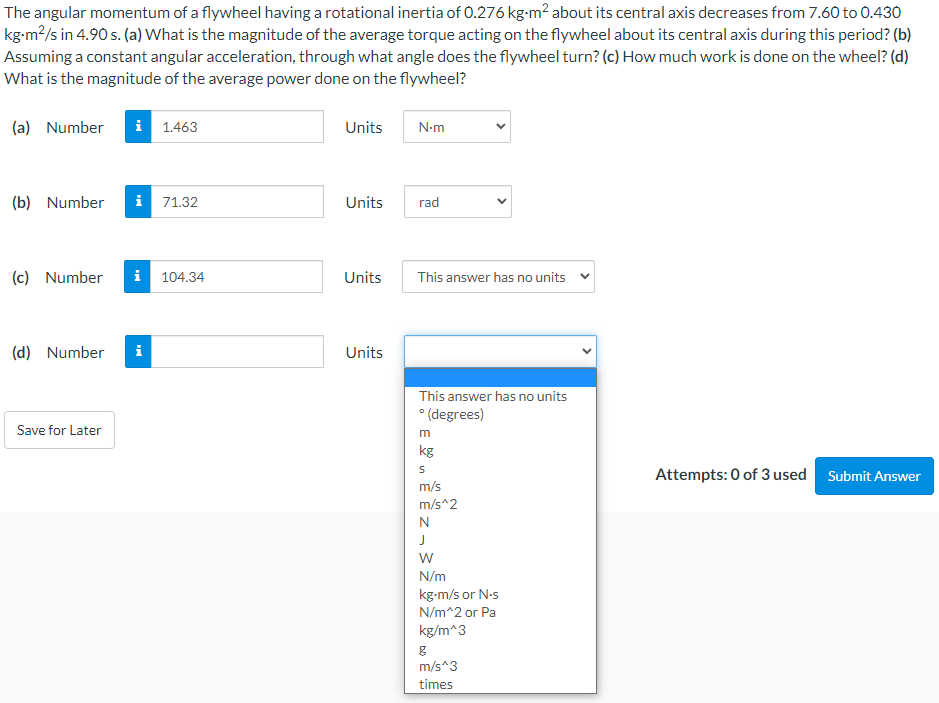The angular momentum of a flywheel having a rotational inertia of .276 kg-m2 about its central axis decreases from 7.60 to 0.430 kg-m²/s in 4.90 s. (a) What is the magnitude of the average torque acting on the flywheel about its central axis during this period? (b) Assuming a constant angular acceleration, through what angle does the flywheel turn? (c) How much work is done on the wheel? (d) What is the magnitude of the average power done on the flywheel?
The angular momentum of a flywheel having a rotational inertia of .276 kg-m2 about its central axis decreases from 7.60 to 0.430 kg-m²/s in 4.90 s. (a) What is the magnitude of the average torque acting on the flywheel about its central axis during this period? (b) Assuming a constant angular acceleration, through what angle does the flywheel turn? (c) How much work is done on the wheel? (d) What is the magnitude of the average power done on the flywheel?
Principles of Physics: A Calculus-Based Text
5th Edition
ISBN:9781133104261
Author:Raymond A. Serway, John W. Jewett
Publisher:Raymond A. Serway, John W. Jewett
Chapter10: Rotational Motion
Section: Chapter Questions
Problem 10P: A wheel 2.00 m in diameter lies in a vertical plane and rotates about its central axis with a...
Related questions
Question

Transcribed Image Text:The angular momentum of a flywheel having a rotational inertia of 0.276 kg-m? about its central axis decreases from 7.60 to 0.430
kg-m?/s in 4.90 s. (a) What is the magnitude of the average torque acting on the flywheel about its central axis during this period? (b)
Assuming a constant angular acceleration, through what angle does the flywheel turn? (c) How much work is done on the wheel? (d)
What is the magnitude of the average power done on the flywheel?
(a) Number
i 1.463
Units
N-m
(b) Number
i 71.32
Units
rad
(c) Number
i 104.34
Units
This answer has no units
(d) Number
i
Units
This answer has no units
* (degrees)
Save for Later
kg
Attempts: 0 of 3 used Submit Answer
m/s
m/s^2
N
J
N/m
kg-m/s or N.s
N/m^2 or Pa
kg/m^3
m/s*3
times
>
Expert Solution
This question has been solved!
Explore an expertly crafted, step-by-step solution for a thorough understanding of key concepts.
Step by step
Solved in 4 steps

Knowledge Booster
Learn more about
Need a deep-dive on the concept behind this application? Look no further. Learn more about this topic, physics and related others by exploring similar questions and additional content below.Recommended textbooks for you

Principles of Physics: A Calculus-Based Text
Physics
ISBN:
9781133104261
Author:
Raymond A. Serway, John W. Jewett
Publisher:
Cengage Learning

Physics for Scientists and Engineers: Foundations…
Physics
ISBN:
9781133939146
Author:
Katz, Debora M.
Publisher:
Cengage Learning

University Physics Volume 1
Physics
ISBN:
9781938168277
Author:
William Moebs, Samuel J. Ling, Jeff Sanny
Publisher:
OpenStax - Rice University

Principles of Physics: A Calculus-Based Text
Physics
ISBN:
9781133104261
Author:
Raymond A. Serway, John W. Jewett
Publisher:
Cengage Learning

Physics for Scientists and Engineers: Foundations…
Physics
ISBN:
9781133939146
Author:
Katz, Debora M.
Publisher:
Cengage Learning

University Physics Volume 1
Physics
ISBN:
9781938168277
Author:
William Moebs, Samuel J. Ling, Jeff Sanny
Publisher:
OpenStax - Rice University

Glencoe Physics: Principles and Problems, Student…
Physics
ISBN:
9780078807213
Author:
Paul W. Zitzewitz
Publisher:
Glencoe/McGraw-Hill

College Physics
Physics
ISBN:
9781285737027
Author:
Raymond A. Serway, Chris Vuille
Publisher:
Cengage Learning

College Physics
Physics
ISBN:
9781305952300
Author:
Raymond A. Serway, Chris Vuille
Publisher:
Cengage Learning